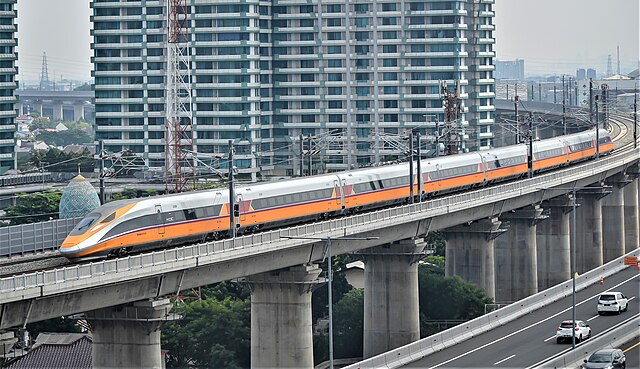At least one passenger is thrilled that a high-speed train that began operating earlier this month has reduced train travel times from Bandung to Jakarta, Indonesia, from 3 hours to 44 minutes. The rail line uses Chinese technology and was financed by China under that country’s belt-and-road initiative.
Indonesia’s high-speed train on a test run before the October 2 inauguration. Photo by Muhammad Bintang Nurandi Putra.
Although the train has a top speed of 210 miles per hour, the rail distance between the two cities is only 88 miles, so the average speed is only 120 miles per hour. The rail line cost $7.3 billion, which was $1.2 billion more than the original projection. At $83 million per mile, that’s comparable to the cost of the high-speed rail line being built in California, thus defying arguments that high-speed rail can be built at a much lower cost.
CNN report that the train “runs on electricity with no direct carbon emissions.” Apparently, the writer was too lazy to add that nearly all of the electricity in Indonesia is produced by burning fossil fuels, so the train produces a huge amount of carbon emissions, albeit indirectly.
Jakarta is supposed to be have some of the worst air pollution in the world, much of which is due to transportation. But it isn’t clear how a high-speed rail line that is mostly outside of Jakarta would fix this. In fact, residents report that construction of the line worsened the region’s air pollution. People who live along the line also complained that the blasting needed for construction damaged their homes, while the railroad responded only that those who are complaining can’t prove that the damage was caused by the construction.
The country wants to build another 466 miles of high-speed rail line, but at $83 million a mile that would be more than $38 billion. This seems unlikely as local economists are already worried about Indonesia’s soaring government debt, which has led Fitch to give it a low BBB rating.
Naturally, American rail advocates are quick to demand that the U.S. build similar high-speed rail lines, such as between Dallas and Houston. Apparently, they aren’t aware that we have these things called jet airliners that can move more than twice as fast as high-speed trains and don’t require expensive dedicated infrastructure.









If Indonesia wanted fast transportation, taken pill for germany’s maglev
Transrapid is as old as 70s. China stole or appropriated the tech to build Shanghai maglev. Never the less, built in 2002 at cost 1.33 billion (2.33 Billion todays money) at 19 miles. But because it’s maintenance is low priority as it has minimal wheels (hovers)………….
Policy wiseness ( or lack of it ) aside, do we know what gauge was used to build this line? Looks like Indonesia has a lot of 3′ 6″ gauge. I can’t imagine running 150mph on a that gauge. Maybe it can be done?
”
Apparently, they aren’t aware that we have these things called jet airliners that can move more than twice as fast as high-speed trains and don’t require expensive dedicated infrastructure.
”
I think we get what you’re getting at. But airports are required and they are dedicated infrastructure. As for expensive, in a way they are. But then again, they’re dirt cheap compared to Cali HSR.
High speed rail might work in tropical countries like Indonesia but they can’t work in the U.S. due to the cold weather in most of our country.
https://twitter.com/tripinchina/status/1715340336019685613?s=12
Also China HSR
https://i.guim.co.uk/img/static/sys-images/Admin/BkFill/Default_image_group/2011/7/25/1311609519897/Chinese-rail-crash-007.jpg?width=620&quality=85&auto=format&fit=max&s=1b6d8c41aa0f026ef7c1fffac7bbe77d
Who needs trains with all the inevitable pileups?
https://www.clickorlando.com/news/2023/10/19/new-video-shows-florida-gov-ron-desantis-suv-after-tennessee-crash/
kx1781,
Airports are expensive because they support millions of passengers per year who are paying ticket fees to cover airport costs. But they don’t need to be expensive. All they really need is a landing field and stairs for large planes. Small planes have their own stairs. A small building for ticketing, baggage, and waiting rooms helps but isn’t required. This is insignificant compared to what HSR needs, and HSR needs expensive infrastructure whether it is used by 10 people or 10 million.
Burdensome government regulations in many countries prevent passengers from parachuting out of their planes when their planes are flying over their destinations. Reforming these outdated rules would greatly cut the costs associated with air travel by slashing costs associated with arrival gates, allowing airplanes to land at remote locations removed from their passengers’ destinations.
Hilarious.
Point is plane isn’t tethered to 1900 miles of infrastructure.
As STOVL technology improves commercial airlines will require shorter runways.
More to point the aviation industry is spending its own money on capital improvement and new engines and technology to make travel more efficient.
Lowering emissions, pollution and reducing fuel consumption via efficiency improvements.